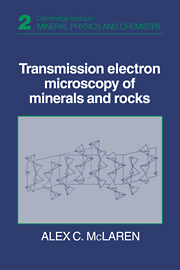Book contents
- Frontmatter
- Contents
- Preface
- Introduction
- 1 Principles of image formation by a lens
- 2 The transmission electron microscope
- 3 Kinematical theory of electron diffraction
- 4 Dynamical theory of electron diffraction
- 5 The observation of crystal defects
- 6 High-resolution transmission electron microscopy
- 7 Chemical analysis in the transmission electron microscope
- 8 Mineralogical applications of TEM – I. Defects and microstructures in undeformed specimens
- 9 Mineralogical applications of TEM – II. Dislocations and microstructures associated with deformation
- References
- Index
6 - High-resolution transmission electron microscopy
Published online by Cambridge University Press: 07 October 2009
- Frontmatter
- Contents
- Preface
- Introduction
- 1 Principles of image formation by a lens
- 2 The transmission electron microscope
- 3 Kinematical theory of electron diffraction
- 4 Dynamical theory of electron diffraction
- 5 The observation of crystal defects
- 6 High-resolution transmission electron microscopy
- 7 Chemical analysis in the transmission electron microscope
- 8 Mineralogical applications of TEM – I. Defects and microstructures in undeformed specimens
- 9 Mineralogical applications of TEM – II. Dislocations and microstructures associated with deformation
- References
- Index
Summary
Introduction
The term high-resolution transmission electron microscopy (HRTEM) is now generally taken to mean an imaging mode in which at least two beams pass through the objective lens aperture. The image produced in this way shows the periodicity of the crystal and, for this reason, is often referred to as a lattice image, A typical example is shown in Figure 6.1. The basic optical principles involved were discussed in detail in Chapter 1 and illustrated in Figure 1.11, but several important aspects of HRTEM have not yet been considered. It is clear that we require a microscope with a resolution of 0.4 nm or better to produce lattice images.
The optical treatment in Chapter 1 is concerned with the nature of the image of a simple two-dimensional grid formed by a perfect lens, in focus, using monochromatic light. However, to understand the nature of the lattice image formed in the electron microscope, we must take into account the thickness and the orientation of the three-dimensional crystal, the defect of focus and the aberrations of the objective lens (see Chapter 2), and the beam convergence, because all these factors influence the relative phases of the diffracted beams that are permitted to pass through the objective aperture.
In this chapter, a brief introductory discussion is given of (i) the experimental variables that influence the nature of HRTEM images, (ii) the experimental techniques involved, and (iii) the basis of image interpretation.
- Type
- Chapter
- Information
- Transmission Electron Microscopy of Minerals and Rocks , pp. 172 - 184Publisher: Cambridge University PressPrint publication year: 1991

